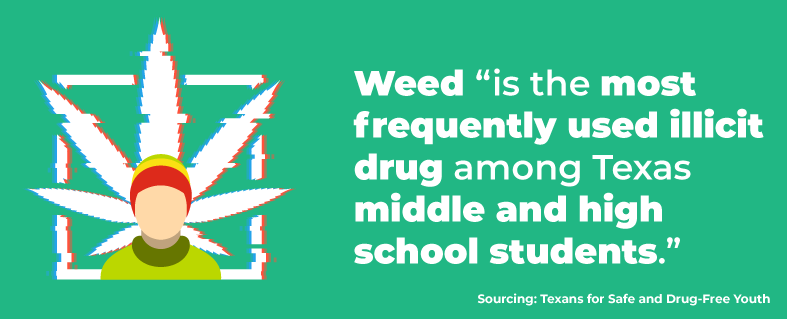We all remember when Colorado legalized cannabis for recreational use in 2012, a move that set the path for the legalization of weed in 15 other states, the territory of Guam, and the nation’s capital, Washington, D.C. You most likely heard on the news that Texas’ neighbor New Mexico joined the movement in April 2021, bringing the total to 17 states that have now legalized recreational marijuana.
In Texas and 18 other states, weed remains illegal for nearly any use, including medicinal, and possession of it (in specific increments) can lead to a fine or jail time and a possible criminal record.
Texas is notorious for its enforcement of marijuana laws. Selling to a minor can result in a felony offense with a 20-year maximum prison sentence. If your teen is in high school, chances are they are regularly around other students who are 18. Passing weed along to a younger friend can lead to a whole new set of legal consequences more dire than when it’s a situation involving two minors.
In addition to the legal ramifications to consider, there are your family’s personal beliefs, individual medications already prescribed, pro-marijuana culture depicted on television and in mainstream songs, and the long-held theory of marijuana being a gateway drug.

Getting Ready to Talk Pot With Teens
As parents, you feel weed, like alcohol and other drugs, is something that should be discussed with your teen, but you might be confused about how to broach the topic. What exactly do you say when your kids ask you about marijuana and whether you’ve ever done it yourself?
Perplexed parents around the country struggle with this conversation every day. And your children could probably put together a powerful argument that leaves you with your head spinning and not even knowing how to respond. Bricolage Behavioral Health encourages a whole-family approach for wellbeing and has provided seven tips to guide you in your open conversation about weed with your teen.
Take a breath before this happens and do some initial research. If you want, ask other parents, your child’s doctor, and school guidance counselors for suggestions, remembering they are just that—suggestions. Then work with your child’s other parent, if possible, to present a unified approach, and invite your teen to the table to begin a conversation. Hopefully, if you’re keeping the lines of communication open, this will be one of several talks you may all have as you work through the teen years together.
1. Educate Both of You
Get the Marijuana Talk Kit, which is produced by the Partnership to End Addiction.
Talk through the statistics together. Read the information together, and keep the conversation going by discussing the topic whenever it hits the news. Keeping it a family discussion rather than a personal behavior attack models strong communication skills for your child and reinforces your role as someone who helps influence their decisions.
Knowing the facts about marijuana’s effects on the adolescent brain and the resources available to seek help if a habit has become an addiction can be a family game-changer.
2. ‘Legal’ Doesn’t Equal ‘Healthy’
Hey, you can head to the local grocery and buy 20 pints of ice cream and eat them all with one spoon. Does that mean it’s smart?
The same rule applies to legal substances like alcohol and tobacco. Health conditions and age also play vital roles as additional things to consider, experts warn.
Effects of Cannabis on the Teenage Brain
Then-U.S. Surgeon General Dr. Jerome Adams issued an advisory in 2019 about marijuana’s effects on the teen brain, noting the following:
- Changes in the brain that affect attention, memory, decision-making, and motivation
- Impaired learning abilities
- Declines in IQ, school performance, and life satisfaction
- Increased rates of school absence and drop-out
- Increased rates of suicide attempts
- Increased risk of psychotic disorders
- Greater likelihood of opioid misuse
“No amount of marijuana use during pregnancy or adolescence is known to be safe,” Adams said in the advisory. “Until and unless more is known about the long-term impact, the safest choice for pregnant women and adolescents is not to use marijuana.”
But your teen, like most, is more likely to be on reddit searching “What did the last episode of Lost mean?” or scrolling through TikTok than researching evidence-based scientific data. And even if it becomes legal in the Lone Star State, teens would still be unable to legally purchase cannabis, as the legal age is 21 even in states that have passed legislation. But then again, alcohol has the same restriction and it remains the most common substance used by adolescents nationwide.
![]()
A 2017 article in Scientific American, “What Pot Really Does to the Teen Brain?”, refers to studies on adolescent use of weed that point to worries that cannabis affects brain efficiencies and mental skills such as judgment, memory, and self-control, as well as delays motor skills. Marijuana can also impact sleep and appetite at such an important stage of physical development.
It’s also a challenge to think of these things existing in a vacuum when environmental impacts—such as poverty, neglect, and abuse—can also play into results, the article points out. Science Journalist Claudia Wallis finished her piece with this lingering sentence:
“On average, adolescents who partake heavily wind up achieving less in life and are unhappier. And those are things a teenager might care about.”

Who’s Using Marijuana and Why
Of the 2.9 million Texans (ages 12+) who said they had used marijuana in the past year, based on 2018-19 data, 271,000 were ages 12-17. Use in the past month was reported as 1.7 million (ages 12+) people, and 148,000 were ages 12-17. For those using marijuana currently and in the past, the percentage of youth stayed the same, with 9% of those using pot being under age 18.
It probably isn’t a real surprise to confirm that marijuana, weed, pot—whatever is the term used at any given time in society—is being used. What’s more important to your family is learning and understanding where teens get their marijuana and why your teen chooses to use or abstain from weed.
Arizona recently completed a statewide youth drug survey and asked eighth-, tenth-, and twelfth-grade students exactly those questions.
Their No. 1, 2, and 3 sources for alcohol or drugs?
- Friends (57%)
- Drug dealers (30.2%)
- Someone with a medical marijuana card (20.3%)
And the top three answers to why they use them?
- Have fun (52.9%)
- Get high or feel good (40.8%)
- Deal with stress from school (38.7%)

Texans for Safe and Drug-Free Youth estimates 14% of Texas teens currently use weed, and 22% have tried marijuana. It reports weed “is the most frequently used illicit drug among Texas middle and high school students.”
Surveys help gain insight into the prevalence of use in your area and other locations, but nothing beats the direct connection of speaking with your teen about important issues in your home and family.
Overdoses Happen When Weed Is Laced
Your teen might be thinking about where they can find weed and may mistakenly believe their friend at school who “got it from a friend” wouldn’t give them something that can harm them.
What they’re not aware of is the warning from the U.S. Drug Enforcement Agency regarding the supply chain from the country’s southern border. Because marijuana is not decriminalized, drug cartels continue to send their unregulated supply north, and there are no guarantees the small amount your teen or their friend ends up with is safe to use.
Why? Fentanyl-lacing is one of the increasingly common stories of tampering with marijuana as fentanyl weighs less, so adding it can reduce transport costs from freight charges. However, this synthetic opioid is dangerous and deadly in amounts as small as one grain, causing psychoactive behavior.
It can also lead to overdose because the unsuspecting person using pot is taking two substances and may exceed toxic levels of one or both. A quick online search will bring up some truly heartbreaking incidents where parents have lost their teens this way.
Evidence Proves Addictive Possibilities
Even if they’re lucky enough to not get a bad dose, there is evidence that those who use pot chronically may have trouble with addiction and health side effects.
“Estimates from research suggest that about 9 percent of users become addicted to marijuana; this number increases among those who start young (to about 17 percent, or 1 in 6) and among daily users (to 25-50 percent). Thus, many of the nearly 7 percent of high-school seniors who (according to annual survey data) report smoking marijuana daily or almost daily are well on their way to addiction, if not already addicted, and may be functioning at a sub-optimal level in their schoolwork and in other areas of their lives.”
National Institute on Drug Abuse (NIDA)

3. Your Child Models Your Behavior
Your alcohol, tobacco, marijuana, and drug use are watched very closely by your children. As they begin to be more aware of the world and are exposed to substances with friends or friends’ parents, they form opinions about what behaviors are acceptable and often use their family as a baseline to compare these outside influences.
This is true of teens with all levels of intellect and from all kinds of home environments, geographic locations, and income levels.
In addition, they may have younger siblings or cousins in their lives who look up to them for guidance when making choices. Remind yourself and your teen of each other’s part in this important role in others’ lives.
4. Be Honest, But Age-Aware
- If you have struggled with a substance in the past and have moved beyond it, being open to sharing your experience can be a powerful deterrent for children in their preteen years.
- As they transition to the teenage years, and you are currently using marijuana but hold your children to another standard, they receive a mixed message and are often left confused or resentful.
- If marijuana is not something your family thinks is appropriate, be honest and share that information at any age.
5. Consider Costs of What Really Matters
Teens are typically hard-pressed to scrounge money for big-ticket items. Whether they have their first paycheck or are saving their babysitting money, they have plenty they would love to buy for immediate satisfaction, like concert tickets, or things they’re saving for later, such as a car or college. Spending hard-earned money on something that doesn’t give them a long-term gain can be enough of a deterrent for any budget-minded teen.
Sharing information about parent expenses at a comfort level that suits you can be beneficial, too. Similar to budgeting for clothes or car purchases, you can discuss that family finances don’t allow for unnecessary extras. You can talk about the value of your paycheck and how you are saving for their college education.
The choices we make with our finances need to be reflected upon, including how they affect future decisions. If you’re saving up for a family vacation, does it make sense for them to secretly spend money on marijuana? Is it ultimately fair to you or disrespectful? Opening this discussion can help them see the family working to achieve goals together.

6. Celebrate Success and Be Mindful of What They Stand to Lose
Looking at their accomplishments and future goals can keep a teen focused on making strong choices. Make a list of their accomplishments and post them in a high-traffic zone as a visual, daily reminder for your teen. What would happen if they lost these benefits based on choices they made? How would it affect them mentally or emotionally?
- Part-time job
- Academic club
- Sports team
- Scholarship
- Letters of reference for college
- Driver’s license
7. Reward Positive Behaviors and Support Interests
Keeping your teen positively motivated is something many counselors stress as a win for parent-child relationships. Reward teens by being supportive when they try new interests or achieve a self-goal. Your relationship moves from authoritarian to more of an interactive one, which is something to strive for as your teen ages and grows into young adulthood.
If your child has a history of smoking marijuana, maybe they can benefit from getting their driver’s license only if they can show they have not used marijuana for an agreed-upon amount of time. Maybe there’s a jacket they have wanted for a while, or they’ve always expressed interest in guitar lessons. These visual reminders and lifelong skills give them positive messages and can help drown out the temptations they may see with friends or even help them choose friends who share their interests.
Keep the Dialogue Ongoing
Since this is meant to be a continuing conversation, feel free to spread out the questions over time, and revisit already discussed topics from time to time. Whether over dinner or during a car ride, ask questions, listen to their answers, and keep the conversation flowing throughout their teen years. Your family will benefit from this increased closeness from a young age through early adulthood.
Mental Struggles May Lead to Addiction Problems
If your teen opens up to you that they have used weed and are struggling with addiction, or you suspect they are, Bricolage can help. It’s not unusual for a child struggling with a mental health issue such as anxiety or depression to reach for a substance to self-medicate. By intervening, you can help them restore a healthy life path of recovery.
Treatment for Marijuana at Bricolage Behavioral
Bricolage Behavioral Health provides evidence-based care for adolescents, including family integration and academic support in the Northern Dallas/Ft. Worth area. Your child will be evaluated for the possible need for dual diagnosis treatment, which means both their marijuana use and mental health will be treated.
Our supportive mental health and teen addiction services are available when you need it most, and our commitment to providing high-quality care has never been more important. We have innovative care with your health in mind! Connect with us at 469-968-5700.
FAQs:
How Can I Deal With Teens and Pot?
It’s best to discuss marijuana with your teenager when you’re both calm and talking about the topic in general. If you’re worried your teen is smoking weed, or you’re finding evidence of use, again, a calm approach is healthier than a parent-child screaming match. Setting clear expectations ahead of time can be helpful but might not always be practical for preventing a child from being tempted when a friend offers.
What Are the Effects of Pot on Teenage Brains?
The U.S. Surgeon General warned marijuana use among teens may affect attention, memory, decision-making, and motivation; cause impaired learning or declines in IQ or life satisfaction. Health risks include a greater likelihood of opioid misuse, psychotic disorders, and suicide attempts.
Marijuana can also be addictive, especially when used regularly and at a younger age. Withdrawal symptoms include irritability, anxiety, disruption of sleep and eating patterns, and substance cravings. Daily use may even decrease chances for a teen to graduate by 60%, some long-term studies of children through their 30s suggest.
What Percentage of Teens Try Pot or Alcohol Before Graduating?
About 14.8% of eighth-graders admitted in NIDA’s annual Monitoring the Future 2020 survey to having tried marijuana in their lifetime, with that percentage growing to 33.3% by tenth grade. By senior year, 43.7% of twelfth-graders said they have tried marijuana at least once.
How Does Marijuana Affect Teenagers and Adults Differently?
Teenagers’ brains are still developing and don’t reach maturity until people are in their mid-20s. Marijuana use affects brain connections that are still developing. It can also change brain shape and structure and be more impactful than alcohol use is on brain development long term.



